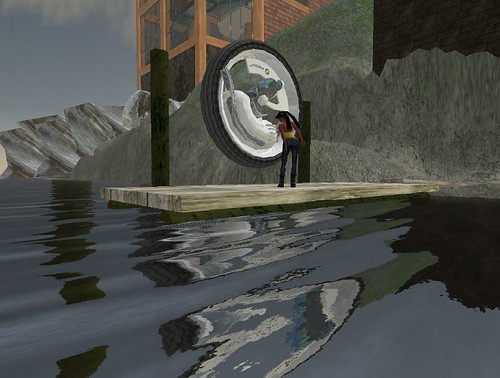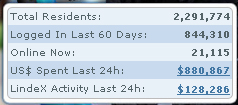There has been so much coverage of the
recent announcement of the SL client being released as open source that it feels unnecessary to repeat the arguments of why it is so crucial to get all the innovative developers — the ones crying for more features — outside of Linden Lab being "brought into the loop", and leave the project management details to LL's own team, as well as the "boring" issues of stability, scalability, and (minor, but relevant for some) bug fixing.
However, the interesting aspect of having the SL client becoming open source — and very soon, the server code as well — is to make essentially Second Life "immortal".
Let me explain this simple concept. While many people are far more comfortable in having Linden Lab "run the show" (and
not the open source community!), they're also afraid of what happens if either an earthquake strikes San Francisco, or Linden Lab going bankrupt, or some other catastrophe occurs (natural or financial). Well, to address the redundancy of the grid, Linden Lab has now servers on a co-location facility in Texas as well. But that is still not enough.
Now, with having the
source code available, we can have a peaceful sleep. If the competition (the one that gets mentioned every time but failed so far to make an appearance) crushes Linden Lab out of business, or if Philip decides to move to an island in the Caribbean and forget all about the "Metaverse thingy" — we, the 2.5 million users of Second Life, can go on.
Because we have the code.
One would argue that it's impossible to set up a volunteer-run grid with 5,000 servers overnight, even with the code. I agree. It won't be the "same" grid — ever. It will have shaky servers, some run from universities, some allowing only 3-4 avatars on a sim, and being run from people's home ADSL connections. But — it will be
a grid. Of sorts. And it can only become better and better.
Imagine the entities having serious stakes in Second Life now: NMC, IBM, the Metaverse Development Companies. What would they do
now if SL disappeared from the face of the earth? They would shrug, grumble, complain, but move to other things instead. And SL would be quickly forgotten like so many other attempts before it (like Lombardi's
ViOS).
But now things have completely changed. They could inhale deeply, shake their collective heads, and say: "ok, LL is out. But we'll keep the torch burning. Let's deploy our own grid and use LL's source code to develop it further". The Big Corps would start rolling out their own sims immediately, since they have the resources to do so. And we'd just get some notice on the MOTD: "Linden Lab is shutting down their grid as of [a date in the future]. But you can connect to [insert Big Corp or Big University name here] grid instead, just point your SL viewer to their grid instead. Click here to know how to do it"
[Second] Life will go on :)
Thus, no matter what ultimately happens to Linden Lab's own grid, the Metaverse built upon Second Life has at least reached immortality. It has critical mass — 2.5 million accounts is, no matter how much we can discuss it to exhaustion, far better than "nothing"! — and it has now the means to "go on beyond Linden Lab". This is quite a difference from everything we have been seeing as "competition" in the recent past — all of them are based on the model that you have to trust the company to stay around. Linden Lab effectively moved the trust into the hands of the
users and the
product.
Old "games" and much software who went open source at some point lived way beyond the "corporate life" of the company producing it. Of course its growth might have been more reduced — without active promotion from a company, it's hard to make an "old" project grow (which explains why MySQL, although being an inferior product to PostgreSQL, is able to grow much more in world-wide attention: it has a company behind it promoting it actively).
Again, Second Life has now an advantage: it has engaged companies and universities to co-promote it. So at the end of the day, it will be the megacorps promoting the SL metaverse more and more, and Linden Lab less and less. We're not there yet, but we'll be — we can, these days, look at the source of press releases and articles about SL and see this happening. In 2003, the only company promoting SL was, obviously, Linden Lab. Nowadays, how many PRs from LL do you see every day, compared to articles from all other sources? So I think we're coming very near to have "critical mass" for promotion.
In conclusion: we have all the requirements (well, missing the open source server; that will come "sooner than later", and now that we know Linden Lab keeps their promises on "going open source", they'll keep that one as well). We have the know-how. We have the strong user base. We have the content creators. We have the support of the megacorps. We have the vision, skill, and talent from the universities.
And we have the source code.
Armed with all that, Second Life will not die a premature death.
As a final thought, one could argue that things like OpenCroquet would be able to do the same (and, in some areas at least, OpenCroquet is "better"). But the ones betting on OpenCroquet or any similar tool are totally missing the point. Remember what it takes to make an open source project thrive — it needs
support from everybody involved in the value chain. OpenCroquet, like many similar products (VR and not VR), has strong
academic support. It has been the source for more PhDs and Master degrees than any other VR platform. But... the user base is tiny, compared to SL. The non-userbase support comes from academia, not corporate business. It's also way harder to use. There is no economy. There is no incentive to use it, except if you're a top programmer without time restrictions or work in an university trying to do a masters' degree on OpenCroquet. There is no grid. In essence,
there is no Metaverse around OpenCroquet — just users and programmers and academic support.
We can now understand a bit better what the "Metaverse" is supposed to be. Not the "ultimate VR tool" (as some friends of mine are fond of saying: "I'll use SL if it gets photorealistic texturing and far better images"). Not the "tinkerer's paradise". Not the delight of happy sysadmins that love complex networked systems. Not at all. The Metaverse will include all those — and they are also crucial! — but they will add the content producers. The Big Corps who want virtual presences. The small SL businesses offering new services. The middlemen (and -women!) who add value on top of programming and content. A stable economy. The global community. The entertainers and the consumers of entertainment.
All of them are required.
Second Life, as we know, is the only tool that has all of the above. Others might have better graphics, a more solid business model, support from either academia or industry, or excellent programmers, or even great content producers. They might even have a better model for their grids — technical and financial. But they all lack a user base — they are "brand new things" — a society, an economy, a model of developing relationships. How long will it take to have all the above emerge from a "new thing"? 4 years at least? Well... you see my point.
Nobody in their right mind would now start things from scratch. Even if you want to get into the "Metaverse Thingy", be clever: don't reinvent the wheel. Grab the source code and develop your own client; then wait for the server source code to be freely available, and tweak it. Then offer services on top of that infrastructure — services that nobody else wants to offer, not even Linden Lab. Who knows, we might even have the "IBM Metaverse" quickly enough (in a year or so).
But the beauty of it is that it will be SL-compatible :) And that is why I think that Second Life has achieved
immortality.



